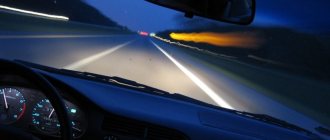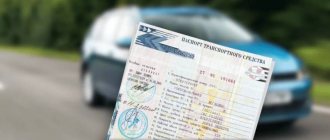In Russia, driving on public roads is prohibited. But for this violation the law provides for a small penalty in the form of a fine. Usually traffic police officers do not pay attention to this, especially when you are driving a car without a front bumper. But if your car does not have this element, then another violation occurs. After all, you don’t have a registration plate in the right place. This is more relevant in the case of the front bumper.
On the rear of the car, due to design features, the license plate is installed on the trunk lid. If it is not, then the court may deprive you of your driver’s license. In the review, you will find out whether it is theoretically and practically possible to drive a car without license plates, register it with the State Traffic Inspectorate, undergo a technical inspection, what the punishment is for this and how to prevent it.
Is it possible to drive without bumpers?
Automotive lawyers are still arguing about this problem. The question is that the Traffic Rules in paragraph 7.18 clearly interpret that you cannot drive a car if design changes are not registered with the traffic police.
For example, if you decide to paint your bumper, or it comes off as a result of a road accident. This element of the car is included in its design. Of course, you will not register this design change, especially since you will be refused. After all, this violates traffic rules regarding road safety. The law provides for a fine for this.
If we approach it from the other side, then auto lawyers and lawyers make references to the Technical Regulations. This is the only legal document that establishes a change in design.
In its text you can find some relevant points, the meaning of which is as follows:
- It is prohibited to remove the “rear safety device”.
- The bumper must not have any damage that could result in metal curves with a radius of up to 5 mm.
It is not entirely clear what kind of rear device is meant. Surely this is not a rear bumper, but a special protection that is installed on large trucks. Damage to the bumper with sharp edges can occur due to dents and tears in the metal. Only the first point is relevant to our question, since there is no bumper on the car after removal.
Therefore, if according to the Technical Regulations it is not prohibited to dismantle the bumper for repair, then there is no change in design. However, the bumper is included in the list of parts for cars and other vehicles. Therefore, its removal can be considered a change in design features.
Purpose of a bumper on a car
On a modern car, the bumper performs several important, unique functions. One of them is purely aesthetic. So, due to its unique appearance, special shape, color, texture, it gives the car a harmonious look, helps to create a colorful car design, attracting everyone's attention to it. In addition, it is entrusted with the most important protective mission - to protect the key structure of the car from deformation in light collisions with other cars or foreign objects. And in the event of a serious accident, it is the bumper that firmly takes the first heavy blow, distracting it from the driver and the people in the cabin.
Exactly the same important tasks face the rear bumper. And if the absence of at least one of them as an aesthetic element of the car is somehow explainable, then the removal of its protective part raises questions, including among law enforcement agencies. They have a reasonable question from the point of view of human safety: why is the car deprived of such protection. Its absence is often interpreted as an unauthorized change in the design of a car prohibited by law, which provides for various penalties.
That’s why driving without a bumper is fraught with punishment for a self-confident driver, and if a motorist still has to resort to it, you need to first understand it well, find out how and how all this can end and in which cases it will be possible to avoid an unwanted fine, and in which it is unlikely whether.
How you are allowed to act
The simplest and most obvious way to avoid punishment for driving a car without a bumper and license plate is to install the warning light approximately in the place where it stood on the bumper. However, there are some nuances.
It is necessary to ensure compliance with the requirements of GOST R50577-93:
- If there is no bumper, then the number must be installed on a vertical surface (radiator, bumper amplifier, if equipped, or other similar elements).
- The license plate must not be obscured by other parts.
- The registration plate itself should not block lighting fixtures and lanterns.
- If you drive without a front bumper, then the registration plate can be mounted exactly in the center or on the left side of the front of the car. It cannot be installed on the right.
- The rear license plate should also be centered or to the left, but should not be tilted more than 3 degrees to the side.
- The front and rear numbers should not tilt forward or backward more than 5 degrees.
- The rear license plate must be located from the road at a height of more than 30 cm to the bottom edge.
- The rear license plate must be visible at 15 degree angles when looking up and down, and 30 degrees left and right.
- It is prohibited to cover the registration plate with coatings, glass or films (even transparent ones).
The main requirement: if there is no rear bumper, then the installation of the rear number plate must ensure its visibility and distinction of numbers and letters from a distance of 20 meters in the dark. However, without a bumper there will be no backlighting of the license plate, so it will be impossible to read it normally. As a result, we can conclude that you cannot drive without a rear license plate. The only exception would be the installation of a separate backlight.
What do you need
If you just drive without a bumper, you also need to know that there are obligations that every driver must fulfill. In this case, you must attach a license plate number to the “facade” of your car. Moreover, they must do this in such a way that the employee does not have any arguments left, adhering to the following criteria:
- Provide a flat, vertical, level surface;
- The sign must be installed along the axis of symmetry of the car or to the left of it;
- The sign must be attached to a frame or using hardware, the color of which matches the field of the sign;
- The mount must not distort the information on the sign;
- The license plate, in turn, should not block light signals and reduce the overhang angles of the vehicle.
These requirements are reflected in the GOST regarding the license plate, and it must be installed in accordance with these standards. By adapting a place to attach the number, you will relieve yourself of some of the charges that may arise from government officials.
What about technical inspection?
Here theory often differs from practice, but not always. The problem is that inspection center specialists often allow cars without bumpers to pass through. However, according to the law, this would be a violation.
The Federal Law on Technical Inspection specifies that the main purpose of this inspection is to monitor whether the vehicle meets road safety requirements. There is no bumper, which means the design has been changed. Therefore, according to the law, you must be denied a diagnostic card. But sometimes they still give it away.
Is it possible to drive a car without a front bumper?
Many people ask whether it is possible to drive without a front bumper. First of all, you need to figure out why exactly such a bumper is missing. If the driver had to remove it, for example, for subsequent repairs or painting, which definitely require considerable time, driving without it is problematic and even risky.
A reasonable question from any traffic police officer about the reasons for such an absence can be convincingly countered only when the driver has an official certificate of a recent accident, as a result of which the bumper had to be removed for correction. However, such an argument is not always effective, and often an unpleasant fine cannot be avoided. In this case, the point is not only that there is no bumper. The situation is aggravated by the fact that the front license plate of the car is usually attached to it. Its installation has its own strict standards: the required height of the sign, the angle of inclination, etc. Since it is very difficult to meet these requirements in the absence of a bumper, when meeting with law enforcement officers, their complaints against the driver may automatically turn to an incorrectly screwed state sign, in violation of the requirements. And the punishment for this violation is much more serious than the usual fine for the banal absence of a bumper.
Because of this, driving without a front bumper becomes doubly undesirable, and experts strongly advise motorists to avoid such options in every possible way in their practice. If the car bumper really requires a thorough repair or painting, the most logical thing to do after removing it is not to go on the road, but to patiently wait for the final completion of all repair work.
Is it possible to drive without one or two bumpers?
Many drivers do not see the danger in driving a car without a bumper, considering the problem to be purely aesthetic. Indeed, in our country there is no serious responsibility for this. However, you can get a fine.
Without front
The car number plates are located on the front bumper. In its absence, the driver has to look for where to attach the state sign. The Code of Administrative Offenses in Article 12.2 (Part 2) prohibits driving without a bumper in a car with no license plates or their location in a place not intended for this purpose.
Often, to remove the bumper, it is necessary to dismantle additional equipment or interfering body elements. This is considered a design violation.
Without rear
Its absence can also be interpreted as a design change. Inspectors may refer to clause 7.5 of the Russian Traffic Regulations, which prohibits driving a car without a rear protective device. However, it is legal for trucks. This is a restrictive structure that prevents cars from driving under the trailer.
Where to attach the car number
The rules for attaching license plates are regulated by GOST R 50577-2018:
Rules for attaching a license plate
An important point is the illumination of the installed license plate, the wiring for which is installed in the bumper. The driver must ensure that the rear license plates are visible from a distance of 20 m at night. The conditions are mandatory, so it is difficult to register a car without a bumper.
Will a car be registered without a bumper?
1 problem that arose when trying to register the car was glass with silk-screen printing and toner in the bulk of the glass, I had to change the glass to transparent, then during the inspection I was told that without a front bumper they wouldn’t let me in (I don’t have a front bumper, so I got it from the previous owner) so I have a question Is there any document regulating the actions of the inspector when inspecting a vehicle? 2. And immediately question 2, will the bumper from 31105 fit 3110? (front)
Comments 16
Each region has its own jokes. I remember buying a donor 3110 with a broken face (headlights, bumper, hood), no one was interested in this, but they also got to the bottom of the brown windows!
Yes, I have a 105 Volga, I just need to repaint the chrome 1 trim and find it and stick it in
buy a simple bumper like on the front of a Zhiguli, made of iron, and then install what you want
Hi all. Guys, tell me, I want to re-register the Volga as my name, but it doesn’t have bumpers (gas 31029, narrow bumpers), when the car is inspected, will the traffic cop find fault with this?
Fine for driving without a bumper
Traffic police inspectors are punished for driving without a bumper under articles for driving a faulty car. If the bumper is removed temporarily, there is a chance to issue a warning.
Intentional changes to the design entail administrative punishment in the form of a fine. The fine for driving without a bumper is 500 rubles.
A more severe punishment awaits the owner of a car without a bumper if its absence led to a violation of GOST for installing a license plate. Attaching a sign to the body of a car without a bumper is sometimes quite difficult. In this case, the traffic police inspector may regard the non-standard fastening as driving without license plates. This administrative offense provides for a fine of 5,000 rubles or deprivation of rights for 1-3 months (Article 12.2 of the Code of Administrative Offenses).
Considering that on some car models it is impossible to install a license plate without a bumper in compliance with all technical conditions, a driver who removes the bumper will most likely lose his license.
Is it possible to drive without a front bumper? The answer is in the article
Is it possible to drive without bumpers?
This issue continues to be debated in 2021. The fact is that clause 7.18 of the Basic Provisions of the Traffic Regulations clearly indicates that it is prohibited to drive a car if changes have been made to its design without registration with the traffic police.
Let's say you removed the bumper for painting, or it fell off as a result of an accident. This part itself is a component of the vehicle. It is logical that you will not, and cannot, register the change, since this affects road safety. And it is natural that there is a fine for this.
On the other side of this issue, many lawyers refer to the Technical Regulations, which is practically the only regulatory act regulating design changes. And in it you can find only 2 close references to our topic:
- It is prohibited to dismantle a certain “rear protective device”,
- The bumper must not be damaged in such a way that it has metal curves (due to a dent, for example), the radius of which is less than 5 mm.
The last option does not apply to us, since we obviously do not have a bumper. But for the second option you need a definition of the term. So, the rear protective device is not a rear bumper at all, but it is installed on trucks and looks like this:
Thus, another point of view concludes that if the Technical Regulations do not prohibit temporarily removing the bumper, then there is no design change at all.
However, the bumper is still a component of the vehicle, so it is nothing more than a change in the structural integrity of the car.
Purpose of a bumper on a car
The bumper is an energy-absorbing body part in the form of a bar located in front and behind the car. The main purpose of the bumper is to protect the car from minor impacts. Thanks to the use of modern materials, the bumper has acquired the ability not only to protect the body in minor accidents, but is also able to harmoniously fit into the design of the car. The bent edges of modern bumpers additionally play the role of spoilers and prevent the formation of a vortex flow during high-speed driving.
But the main purpose of the bumper is to protect the body from mechanical damage. Of course, in the event of a serious accident, you should not expect any protective function from a plastic bumper. It can only serve as protection in the event of a collision with a pedestrian or stationary object at low speeds.
On modern cars, the bumper is also necessary for installing fog lights, parking system sensors, and in some models for attaching license plates. Thus, the bumper is a necessary structural part of the car, and its dismantling is recognized as making unauthorized changes to the design of the vehicle.
Important note!
- This article provides basic information, but each case is different.
- In 92% of all situations there are important nuances that can affect the outcome of the entire case.
- An experienced lawyer will study all the materials of the case and indicate in which direction to move.
Therefore, our website employs on-duty legal consultants who delve into each case and are aimed at solving it.
or consult toll-free (Moscow), (St. Petersburg), 8 (all of Russia).
Will the punishment change in 2021?
There is currently no information about upcoming bills that will regulate noise levels and penalties for it.
Of course, people suffering from the actions of disturbing motorists would like tougher measures. Moreover, this concerns not only the noise from the exhaust system of cars, but also from listening to music and renovations being carried out in apartments.
However, so far this problem does not seem serious enough to legislators to introduce new sanctions.
Where to attach license plates without a bumper?
So, let's first find out exactly what not to do:
- driving without bumpers and without license plates at all - the conclusion that if there is no part where the GRZ is attached, then the registration plate itself can be removed is fundamentally incorrect,
- put the license plate number under the windshield.
For both of the above methods, you will receive Part 2 of Article 12.2 of the Code of Administrative Offenses, which entails either a fine of 5,000 rubles or deprivation of rights for 1-3 months.
The simplest and most obvious way to avoid a fine for driving without a license plate and without a bumper is to attach the license plate to as much as possible in the same place where it was if there was a bumper. But there are a number of subtleties.
It is necessary to ensure compliance with GOST R 50577-93:
- if there is no bumper, the license plate must be fixed on a vertical surface (for example, on the amplifier, if one remains, or on the radiator),
- it should not be blocked by other elements,
- the number itself should not block the lighting fixtures,
- if you are driving without a front bumper, then the number can be fixed either strictly in the middle or to the left - it is impossible to the right of the middle,
- the rear license plate must also be in the middle or on the left, but one of its edges must not be inclined by more than 3o,
- the inclination of both reg signs forward or backward should be no more than 5o,
- the rear GRZ must be at least 30 cm from the road (its lower edge),
- The rear license plate must be visible from the following angles:
- you cannot cover the room with films, glass or any other – even transparent – coverings,
- Part 1 covers the general provisions of the legislation, defines its objectives and scope of influence;
- Part 2 provides explanations of highly specialized terms used in the document.
- Part 3 establishes the rules for vehicles for putting them into service and placing them on the market;
- Part 4 provides requirements for the safe use of vehicles;
- Part 5 defines the procedure for assessing the compliance of various types of transport with the prescribed standards;
- Part 6 establishes the obligation to mark wheeled vehicles with a single mark of circulation on the market;
- Part 7 provides for safeguard clauses;
- Part 8 contains the final provisions on the entry into force of the document.
But the main requirement, if you drive without a rear bumper, is that you must ensure that the rear license plate number can be read from 20 meters in the dark. And, since you do not have a license plate backlight, this is not possible. That is why we can conclude that driving without a rear bumper is basically prohibited.
What are the consequences for driving without a muffler?
Driving without a muffler, with a broken muffler or with a direct-flow exhaust system installed (instead of a quiet factory muffler) is a malfunction (under Part 1 of Article 12.5 of the Code of Administrative Offences) or a change in the design of the car (under Clause 18 of Section 7 of the Traffic Regulations). This will result in a verbal warning or a fine of 500 rubles.
What unites the above cases is that the noise level from the exhaust exceeds permissible standards - that is, 96 dBA for passenger vehicles and 98-100 dBA for trucks and buses. Factory standards for a specific car model are specified in the operational documentation, but usually they do not exceed the figures indicated above.
Noise level measurements are carried out by traffic police officers in accordance with GOST No. 52231-2004, subject to a number of conditions and requirements. A tachometer, microphone and sound level meter are used for this. Additionally, to record external conditions, a thermometer, a protractor, a stopwatch, a barometer, a tape measure, and instruments for recording noise and wind speed are used.
Will they be registered?
No. If above we discussed the theoretical part of the violation of driving without a bumper, then in practice the inspectors of the traffic police MREO have the same opinion. The absence of a bumper is a design change that affects safety, so registration on this basis in 2020 may be legally denied to you.
What about the number?
It is during the period of repair of his bumper that the motorist has the right to use his vehicle without violating traffic rules. But one more factor should be taken into account. This is a license plate mount. If on a car model they are to be installed on the bumper, then during its absence, they should be attached to the right side of the car in the direction of its movement.
Their absence will become a serious offense, and then the owner of the car will pay monetary compensation in the amount of 5,000 rubles, or may lose the right to drive a car for up to three months.
If, nevertheless, it was not possible to avoid responsibility, and the driver was issued a fine, then you can take advantage of a discount when paying for it if you are well aware of the traffic rules and current legislation, namely Art. 32.2, according to which discounts are determined for certain offenses. If you pay the fine and register it in the database no later than 20 days from the moment the decision was made, then you can pay only 50% of the fine amount, that is, 250 rubles.
Optics
Optics are subject to strict restrictions on alteration. Only the installation of fog lights and daytime running lights is allowed, and then with certain conditions at the installation site. There is a very strict restriction on the color of lighting devices: nothing white or red can be used. These colors are already assigned to the head optics and brake lights. But if you look for loopholes in the technical regulations, then you can talk about illuminating the bottom, although in this case it is necessary to use only permitted colors.
The installation of non-standard, tuned optics is also permitted, but provided that these optics have passed certification, otherwise the car may be “turned down” at the inspection station. But installing LEDs in standard optics is prohibited. Or rather, it is allowed if the manufacturer allows it, but Avto25.ru journalists could not remember a single such case. It is clear that when the optics are initially designed for diodes, then they can and should be installed, but if not, then no.
A subtle point with xenon. Self-installation is prohibited. It is self-made in the sense that you cannot place xenon in headlights whose markings begin with the letter H. But, in principle, if you buy special headlights for xenon (markings begin with the letter D), equip the car with a headlight washer and a corrector, then such a modification is quite possible register. And, of course, the owner should not worry if the xenon on the car is factory.
For honest xenon you need special headlights
Basic provisions of the law on car tuning
The law on car tuning is the Technical Regulations of the Customs Union “On the Safety of Wheeled Vehicles,” which was approved by decision of the Customs Union Commission No. 877 on December 9, 2011.
The regulation defines safety requirements for wheeled vehicles in order to ensure the protection of the life and health of citizens, their property, as well as to ensure environmental protection.
The safety regulations are supplemented by 12 annexes with diagrams and graphs that define the exact requirements for all types of wheeled vehicles and individual components for their operation, circulation, labeling, identification, design and modification. The appendices also provide a list of necessary documents for cars and their spare parts, including features and rules for processing these papers.
The latest changes to the regulations took place on December 13, 2021 and affected the list of acceptable equipment on wheeled vehicles, which was supplemented by a number of technical means for satellite navigation.
In accordance with the law on changes in the design of a car, a vehicle can be converted only if the manufacturer provides this opportunity. These changes do not require permission from the traffic police; the relevant documents for the installed equipment and confirmation of the technical service about the work done are sufficient.
The parts being installed must match the make and model of the vehicle, be manufactured by a licensed manufacturer, and meet safety requirements. Their installation must be carried out in accredited service stations, about which a corresponding note is made in the vehicle passport. If the equipment changes the original technical parameters of the car, its installation requires permission from the traffic police and subsequent re-registration.
In accordance with the provisions of the law on car modifications, it is prohibited to install new parts or replace old ones with similar ones, which lead to changes in the technical characteristics of the vehicle provided by the manufacturer.
The following changes are prohibited:
- engine replacement;
- installation of fixed equipment;
- the number of seats in the cabin, if this is not provided by the manufacturer;
- change of body type;
- modification of the fuel and brake systems;
- making changes to the steering system, including the steering wheel of the car;
- installation of another exhaust system;
- changing the lighting system;
- replacing or adding aerodynamic elements;
- installation of dark tinting on windows;
- replacing wheels with a different type (radius, width);
- installation of gas equipment;
The law prohibits any modifications to the vehicle that are not provided by the manufacturer and do not comply with safety regulations, as this can lead to the creation of emergency situations on the roads.
Engine and exhaust system
Everything is complicated with the engine. On the one hand, the engine not so long ago ceased to be a numbered unit and became an ordinary spare part, on the other hand, the engine model is still included in the PTS and the tax is paid precisely according to its power. That is, replacing the engine with another without re-registration is prohibited. But this is not controlled in any way, because now the traffic police don’t check the serial number - put what you want. It is clear that if a VAZ “nine” arrives with an 8-cylinder engine, the replacement will be visible to the naked eye, but hardly anyone will be able to tell the difference between outwardly similar engines.
What if with re-registration? You can legally install a motor if the car with it has a certified version from the manufacturer. Let's say, if you are the owner of a 41st Muscovite with a Ufa or VAZ engine, then you can easily install a two-liter Renault F3R instead, because the plant produced such modifications. Otherwise, the traffic police will require you to obtain a certificate, which is quite expensive and difficult.
Self-installation of turbines and compressors is also prohibited, but problems arise only among owners of the domestic automobile industry. Traffic police inspectors don’t know the engine compartment of foreign cars well, so they may simply not see the turbine there. In common cars it is more noticeable, but it can still be passed off as an “injector design” or a “noise reduction device.”
The fight against non-standard exhaust systems began only a couple of years ago, although they have always been formally illegal. Now, during the technical inspection, the “loudness” of the car is checked, so owners of direct flow vehicles will most likely not receive a maintenance ticket on their own. Although it is no secret that this is a small problem for our country.
Not everyone can notice the turbine
What prompted the adoption of the law?
The ban on car tuning in 2021 was adopted in connection with tightening measures to combat dangerous driving. This has recently been often written about in periodicals and featured on television programs - the increase in the number of street racers became the starting point in initiating this initiative.
According to the law adopted in 2021, all cars with non-standard equipment that has not been certified are illegal. According to the traffic police, they also create a greater likelihood of traffic accidents on the road.
This is primarily due to the fact that recently the installation of alternative optics on cars has become very popular, which often does not meet standard requirements.
List of car elements that are not allowed to be changed
The new law on tuning, which was adopted this year, lists those parts of the car that are not allowed to be modified without the appropriate permission. You can see that it is quite impressive and leaves little room for improvements and creative experiments:
- Driver and passenger seats;
- Suspension;
- Bumper;
- Steering wheel and its entire system;
- Exhaust elements;
- Lockers;
- Exterior lights;
- Aerodynamic elements;
Aerodynamic body kit "G-Power Typhoon"
- External sources of additional light;
- Wheel spacers;
- Top trunk;
- Non-standard colors of halogen lamps;
- Xenon lights;
- Alteration of thresholds;
- Gas equipment;
- Wheel arches of non-standard design;
- Kanguryatniki;
Kenguryatnik for car
- Advertising screens;
- Light boxes.
Moreover, this list is far from complete - the tuning ban includes cars with any adjustments that are not structurally provided for in them. If you look at it, more than seventy percent of cars are prohibited from operating, based on innovations in legislation.
It is a widespread practice among motorists to install wider wheels and tires on their cars, which provide high adhesion to the road surface. To increase ground clearance, spacers are often used for suspension springs. Owners of off-road vehicles often install homemade roof racks made of welded pipes on the roof. Now all this is prohibited by the new legislation - many drivers will have to be content with what is offered to them by the car manufacturers themselves.
Wheels wider than required
Source: https://ytaxi40.ru/registraciya-ts/shtraf-za-otsutstvie-perednego-bampera.html
Let's summarize the dangers of traveling without bumpers
You can make sure that there is no outright and direct violation of traffic rules in the case of a trip without bumpers. If this is not a permanent change, removing the bumper does not affect the location of the license plate, and the design and functionality of the car does not change, you can safely operate the car without this plastic element.
The only problem is the constant stops by the police. In some cases, the police simply do not know the rules well enough; sometimes they just want to make money. If you know the traffic rules and the relevant articles of the Code of Administrative Offenses very well, you will never find yourself in an unpleasant situation.
What is the fine for driving a car in 2021?
Violation of traffic rules 10.22.201808.04.2020 admin Deprivation of rights, traffic rules, warning, fine Almost every change in the design of a vehicle entails the need for documentation.
The main purpose of the bumper is to protect the car from minor impacts. Thanks to the use of modern materials, the bumper has acquired the ability not only to protect the body in minor accidents, but is also able to harmoniously fit into the design of the car.
Otherwise, such an action by the owner of the car or the person driving it becomes the basis for bringing him to justice and incurring punishment in accordance with the article of the Code of Administrative Offenses.
The fine for a power bumper or kanguryatnik, as drivers often call it among themselves, also applies to this type of violation and under certain circumstances it can reach impressive sizes. Rules and regulations that must be taken into account when installing a power bumper When intending to install a power bumper, the motorist must understand that such a device must have the following characteristics to comply with the requirements: The presence of durable metal and reliable grilles at the base of the device;
How to place a license plate if the bumper is removed?
The biggest problem in the case of temporary dismantling of a plastic body part is the location of the state registration plates. Previously, you could put a sign under the glass and drive like that for several weeks while the bumper was being repaired. But with the introduction of cameras that automatically record violations, problems with this point arose. In particular, here are some requirements for license plate placement:
- The location for installing the sign is an exclusively flat vertical surface at the front of the body.
- Signs should not protrude beyond the side of the car or be positioned in such a way as to reduce the overhang angles of the car.
- The installation must be along the axis of symmetry, deviation to the left is allowed.
- The distance to the bottom edge of the sign is a minimum of 300 mm, to the top - a maximum of 1200 mm.
- It is important to place it in a flat plane so that the sign is not tilted back or tilted forward.
- Fastening can be done using bolts, screws or frames.
- Elements of the car's design must not overlap the state license plate.
- Fasteners must not cover the elements of the license plate, numbers and inscriptions on the plate.
If you can follow all these rules after removing the bumper, then you don’t have to worry about possible fines. But you will have to communicate with traffic police officers quite often. Police officers themselves do not always know the rules well enough and act more out of habit. Therefore, it is worthwhile to have a good understanding of the legislation in order to properly respond to traffic police officers when stopped. Driving without a front bumper is an opportunity for police to make money, and this is worth remembering.
Situations in which a car is sold without documents
There may be several such cases:
- if the car acts as collateral, for example, when buying on credit, then the document is with the lender;
- homemade vehicles that were assembled by people from available materials, or a car containing a huge number of technical changes;
- the car being sold was stolen;
- or the owner’s passport was lost; how to restore the PTS will be discussed below;
A problem car can be sold by all sorts of scammers - the documents are invalid, the owners have disappeared, and the car itself is completely creditable. Or, some scammers may try to prove to an inexperienced buyer that there is no PTS and it is not required, but there is an STS and this is enough for registration, but this is not the case.
Is it possible to avoid a fine for driving without a bumper?
You can avoid a fine for driving without a bumper if you can prove to the inspector that it is temporarily absent.
This can be done on the basis of a certificate of an accident or by convincing him that the bumper is in service. If the bumper is removed intentionally, the driver needs to take a number of measures so that the traffic police officer has nothing to complain about. The main problem with the absence of this part on the car is the inability to attach the license plate, since in most car models the license plate is attached to the bumper.
Experts advise doing the following:
- Install on the front part of the car body, along the axis of symmetry or to the left of it, a flat, level surface for installing the state registration number.
- The number must be attached to a special frame or to the base. The fastenings must match the main field in color.
- The mount must not obscure or distort the license plate information.
- The number must be positioned strictly vertically, with a permissible deviation of no more than 5 degrees.
- In turn, the number should not block the light signals of the car and reduce the clearance between the body and the road surface.
These requirements for attaching state registration numbers to a car are established by GOST, so violation of any of the points is not permissible.
Important. If the license plates on a car without a bumper are installed in compliance with all technical requirements, and the inspector still imposes a fine, it is worth challenging his decision in court. In this case, it is advisable to involve an experienced lawyer in the case who can prove that the car owner is right.
The question of driving without a bumper does not have a clear answer and depends entirely on the loyalty of the inspector who stopped the car. Practice shows that in approximately half of cases it is not possible to avoid a fine. Therefore, to save money, it is better not to edit the appearance of the car and not remove the bumper from its body.










